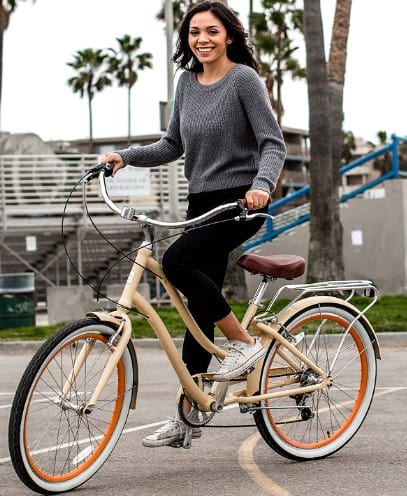One thing you are likely to notice first when shopping for a bike is its size. While most bike frames come in multiple sizes, others only come in one size. So, the question is, ‘why does bike frame size matter?’
The bike frame size matters because it determines your cycling posture and comfort. A wrong frame size messes up your posture, translating to body pains like backache, wrist pain, and knee pain, among other issues.
I’ll take you through the good and the bad of getting a bigger or smaller bike frame. I should assert, however, beforehand that nothing is better than getting your size.
For that reason, I’ll show you how to determine your perfect bike size using your inseam length. But before that, let me explain more about why the frame size matters.

Why Does Bike Frame Size Matter?
Let’s look at two scenarios here that’ll help us arrive at the answer.
A Bike Frame That’s Too Big
Here’s what you get from a bigger bike frame:
- Longer Reach
The reach refers to the horizontal distance from the mid head tube to the mid-bottom bracket.
Generally, you lengthen your reach by getting an oversized frame, creating a more relaxed geometry, which translates to a more relaxed posture.
The geometry offers you more room to flex, which is suitable for casual riding.
- Larger Wheelbase
A bigger frame size also means have a longer wheelbase. The wheelbase refers to the distance between the two bike wheels.
The advantage of having a larger wheelbase is that it offers you more stability. So, you’ll always feel like you are in control of the bike.
That’s generally a good thing when taking on trails with an MTB.
A Bike Frame That’s Too Small
Here’s what you get from a smaller frame:
- Shorter Reach
If the frame size is smaller than your body size, you’ll have a shorter reach. One advantage is that you hold the bike better, which translates to a responsive feel.
But other than that, there’s nothing more to relish.
One thing that a small frame does to you is that it forces you to stay rigid. Since the reach is shorter, you cannot help but sit head up.
The downside of such a posture is that it denies you the opportunity to sit in a better pedaling position.
Though you can handle the bike better, you cannot move it freely.
- Smaller Wheelbase
A shorter frame also translates to a shorter wheelbase. Since the two wheels are closer, you get a much stiffer bike frame.
Usually, this is not a problem if it’s a performance bike like a road bike or MTB. Such bikes require you to sit more aerodynamic for an aggressive ride.
It’s, however, a problem if the bike is a casual or commuter option as you are likely to strain.

The Risks Of An Incorrect Bike Frame Size (Why Bike Size Matters)
We’ve seen that both bigger and smaller bicycle frames have a few advantages. But are the frames worth it?
My answer is NO, and that’s due to these risks:
1. Backache
An incorrect bike frame, especially a smaller one, puts your back under unnecessary stress as you stay rigid.
It doesn’t go well with your lower body if you’ve to stay stiff for long hours. As a result, it’s likely to start hurting.
And if the reach is longer, in the case of an oversized frame, you’ll be forced to bend a lot, and that’ll also hurt your back.
2. Knee Pain
A small bike frame, in particular, is likely to hurt your knees. Such a frame only offers your knees a smaller room to move, which means you are likely to pedal hard.
Doing so could rupture your soft knee tissues, resulting in pain.
3. Wrist Pain
Your wrists are likely to take a bruit hit when you ride a bike that’s not your size. Primarily, that’s because you are likely to have a poor body stance, which puts excess pressure on your wrist.
Larger frames require you to stretch and reach further, while smaller frames reduce your Reach. Either way, the experience is uncomfortable for your wrist.
4. Body Fatigue
An incorrect frame size also interferes with your pedaling efficiency. It makes it harder to pedal, and as a result, you are likely to put in a lot of effort.
In the end, you get fatigued much faster than someone riding the same bike type but of the correct frame size.
5. Risk of Crashing
The other risk and irrefutably the gravest of them all is that an incorrect bike frame size could make you crash. If the frame is not your match, you won’t have the best control and will likely crash.
So, Is It Better To Get A Bigger Or Smaller Bike Frame?
After looking at the risks of getting either a bigger or smaller bike frame, I believe it’s not worth going either route.
Yes, both frames have a few advantages, but the risks are more. So, if I were you, I would instead get the correct frame size.
You want a bike that you can control and pedal efficiently. You also want one that doesn’t strain your back, knee, or wrist.
Frankly, you can only have that if you get your size.
But does that mean that you should write off your bike because it’s not your size? Of course not, more so if it’s one size smaller or one size bigger.
Remember, bikes are adjustable. So, there are a few tweaks to try out to try and improve the bike’s fit.
Let’s discuss them next.

How To Fix A Bike Frame That’s One Size Small or One Size Big
A Smaller Bike Frame
A smaller bike frame by one size usually is easy to fix using these adjustments:
- Consider raising the seat post to improve the saddle height. But if the seat post has reached its maximum extension limit, replace it with a longer seat post that matches its diameter
- Get a longer stem to push the handlebar further forward and make the frame appear massive.
- Try raising the handlebar using bar risers (View on Amazon)
A Bigger Bike Frame
You can also fix a frame that’s bigger than one size using these tips:
- Lower your seat post
- Bring the handlebars close to you by replacing a longer stem with a shorter one
- Try removing the spacers to lower the handlebar and make your frame appear smaller.
How Do I Choose The Right Bike Frame Size?
Generally, choosing the right bike frame depends on two things: your inseam and height.
Of course, you can use either the inseam or your height to find your ideal frame size.
Let’s start with the inseam (inside leg).
You can determine your inseam length by:
- Standing straight against a wall and putting your legs at least 6-inch apart. Ensure you take off your shoes.
- Measure in cm the distance between the ground you are stepping on and the crotch. That’s your inside leg/inseam measurement.
- Then use any of these formulas depending on the bike frame you want to buy:
- MTB = Inseam X 0.66
- Road Bike = Inseam X 0.77
- City Bike/Hybrid bike = Inseam X 0.685
You can also determine your frame size by looking at your height. To help you with that, here’s a bike frame size chart for reference.
| Your Height | Inseam (cm) | Bike Frame Size (inch) |
| 147-156cm | 63-84cm | 14inch |
| 157-166cm | 67-88cm | 16inch |
| 167-177cm | 72-93cm | 18inch |
| 178-184cm | 77-96cm | 20inch |
| 185-200cm | 83-104cm | 22inch |
Use the above chart to compare a small vs medium bike frame.
FAQs
1. Does Bike Frame Size Really Matter?
The bike frame size does matter as it determines your cycling posture and overall comfort. A wrong frame means an uncomfortable posture, which translates to body pains and poor bike handling.
2. Does It Matter If Bike Frame Size Is Too Small?
A bike frame that’s too small has a shorter reach and a smaller wheelbase. While such modifications offer you better bike handling, you’ll strain your wrist and back, resulting in unnecessary pain.
3. What Should The Frame Size Be For Bike?
You should get a bike frame size that matches your inseam and height, and here is a table to use:
| Your Height | Inseam (cm) | Bike Frame Size (inch) |
| 147-156cm | 63-84cm | 14inch |
| 157-166cm | 67-88cm | 16inch |
| 167-177cm | 72-93cm | 18inch |
| 178-184cm | 77-96cm | 20inch |
| 185-200cm | 83-104cm | 22inch |
4. Is It Ok To Buy A Bike One Size Smaller?
It’s never smart to buy a bike one size smaller. Such a bike will force you to sit stiffly and will not offer you enough room to pedal and control the bike. In the end, you’ll have a more uncomfortable ride.
5. Can You Ride A Bicycle One Size Too Big?
Though it’s possible to ride a bike one size too big, you are likely to stretch your body beyond your comfort level. You’ll likely bend trying to reach for the handlebar, and that’ll strain your back and wrist.
Relevant:
Closing Thought: Why Does Bike Frame Size Matter?
Generally, the frame size is essential as it dictates your cycling posture and comfort.
Get it wrong, and you’ll hurt your posture. In contrast, get it right, and you’ll ride safer and comfortably. That’s it!